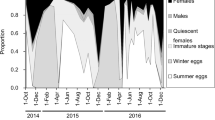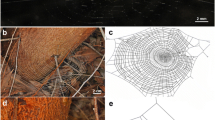Abstract
Male spider mites (Acari: Tetranychidae) guard preimaginal quiescent females to reserve paternity. In a few species of Stigmaeopsis that make densely woven silky nests on the surface of host plants, mature males attack and even kill rivals to gain their rights to inseminate young females in the nest. Here we report that the adult males of Schizotetranychus brevisetosus (Acari: Tetranychidae), whose web nest construction behavior evolved independently from Stigmaeopsis spp., also exhibit highly aggressive behavior towards one another. Combat mortality was measured in an experimental design where two males in the treatment group were forced to live in a nest made by adult females on a leaf arena, while one male in the control group was allowed to live in a nest on another arena. We found that the 5-day mortality of males in the treatment group (56 and 37 % in two replicates) was significantly higher than in the control group (9 and 12 %) and that lethal combats frequently arose in the treatment group. However, we found no consistent trend for the length of the first legs, which is known to affect the outcome of battle in Tetranychus urticae and Stigmaeopsis miscanthi. This might be due to a relatively small number of measurable specimens, and the effects of body size should be explored in future studies.



Similar content being viewed by others
References
Arnqvist G, Rowe L (2005) Sexual conflict. Princeton University Press, Princeton
Boudreaux HB (1963) Biological aspects of some phytophagous mites. Annu Rev Entomol 8:137–154
Chae Y, Yokoyama N, Ito K, Fukuda T, Arakawa R, Zhang Y-X, Saito Y (2015a) Reproductive isolation between Stigmaeopsis celarius and its sibling species sympatrically inhabiting bamboo (Pleioblastus spp.) plants. Exp Appl Acarol 66:11–23
Chae Y, Yokoyama N, Ito K, Fukuda T, Arakawa R, Zhang Y-X, Saito Y (2015b) Erratum to: Reproductive isolation between Stigmaeopsis celarius and its sibling species sympatrically inhabiting bamboo (Pleioblastus spp.) plants. Exp Appl Acarol 66:25–27
Crawley MJ (2005) Statistics: an introduction using R. Wiley, West Sussex
Dattalo P (2008) Determining sample size: balancing power, precision, and practicality. Oxford University Press, New York
Dimock RV Jr (1983) In defense of the harem: intraspecific aggression by male water mites (Acari: Unionicolidae). Ann Entomol Soc Am 76:463–465
Emlen ST, Oring LW (1977) Ecology, sexual selection, and the evolution of mating systems. Science 197:215–223
Enders MM (1993) The effect of male size and operational sex ratio on male mating success in the common spider mite, Tetranychus urticae Koch (Acari: Tetranychidae). Anim Behav 46:835–846
Faul F, Erdfelder E, Lang AG, Buchner A (2007) G*Power 3: a flexible statistical power analysis program for the social, behavioral, and biomedical sciences. Behav Res Methods 39:175–191
Hamilton WD (1967) Extraordinary sex ratios. Science 156:477–488
Linquist EE (1985) Anatomy, phylogeny and systematics. 1.1.1 External anatomy. In: Helle W, Sabelis MW (eds) Spider mites: their biology, natural enemies, and control, vol 1A. Elsevier, Amsterdam, pp 3–28
Łukasik P (2010) Trophic dimorphism in alternative male reproductive morphs of the acarid mite Sancassania berlesei. Behav Ecol 21:270–274
Matsuda T, Morishita M, Hinomoto H, Gotoh T (2014) Phylogenetic analysis of the spider mite sub-family Tetranychinae (Acari: Tetranychidae) based on the mitochondrial COI gene and the 18S and the 5′ end of the 28S rRNA genes indicates that several genera are polyphyletic. PLoS ONE 9:e108672
Oku K (2014) Sexual selection and mating behavior in spider mites of the genus Tetranychus (Acari: Tetranychidae). Appl Entomol Zool 49:1–9
Potter DA, Wrensch DL (1978) Interrupted matings and the effectiveness of second inseminations in the twospotted spider mite. Ann Entomol Soc Am 71:882–885
Potter DA, Wrensch DL, Johnston DE (1976a) Aggression and mating success in male spider mites. Science 193:160–161
Potter DA, Wrensch DL, Johnston DE (1976b) Guarding, aggressive behavior, and mating success in male twospotted spider mites. Ann Entomol Soc Am 69:707–711
R Core Team (2014) R: a language and environment for statistical computing. R foundation for statistical computing, Vienna
Radwan J, Czyż M, Konior M, Kolodziejczyk M (2000) Aggressiveness in two male morphs of the bulb mite Rhizoglyphus robini. Ethology 106:53–62
Saito Y (1983) The concept of “life types” in Tetranychinae. An attempt to classify the spinning behaviour of Tetranychinae. Acarologia 24:377–391
Saito Y (1990a) Factors determining harem ownership in a subsocial spider mite (Acari, Tetranychidae). J Ethol 8:37–43
Saito Y (1990b) ‘Harem’ and ‘non-harem’ type mating systems in two species of subsocial spider mites (Acari, Tetranychidae). Res Popul Ecol 32:263–278
Saito Y (1995) Clinal variation in male-to-male antagonism and weaponry in a subsocial mite. Evolution 49:413–417
Saito Y (2010) Plant mites and sociality. Springer, Tokyo
Saito Y, Sahara K (1999) Two clinal trends in male–male aggressiveness in a subsocial spider mite. Behav Ecol Sociobiol 46:25–29
Saito Y, Mori K, Chittenden AR (1999) Body characters reflecting the body size of spider mites in flattened specimens (Acari, Tetranychidae). Appl Entomol Zool 34:383–386
Saito Y, Chittenden AR, Mori K, Ito K, Yamauchi A (2008) An overlooked side effect of nest-scattering behavior to decrease predation risk (Acari: Tetranychidae, Stigmaeidae). Behav Ecol Sociobiol 63:33–42
Sakagami T (2002) Phylogenetic analysis of subfamily Tetranychinae (Acari: Tetranychidae) in Japan, based on 28S ribosomal DNA sequences: does the celarius group belong to the genus Schizotetranychus? Hokkaido University, Ph.D. dissertation
Sato Y, Saito Y (2007) Can the extremely female-biased sex ratio of the social spider mites be explained by Hamilton’s local mate competition model? Ecol Entomol 32:597–602
Sato Y, Saito Y, Chittenden A (2008) The parapatric distribution and contact zone of two forms showing different male-to-male aggressiveness in a social spider mite, Stigmaeopsis miscanthi (Acari: Tetranychidae). Exp Appl Acarol 44:265–276
Sato Y, Egas M, Sabelis MW, Mochizuki A (2013a) Male–male aggression peaks at intermediate relatedness in a social spider mite. Ecol Evol 3:2661–2669
Sato Y, Sabelis MW, Egas M, Faraji F (2013b) Alternative phenotypes of male mating behaviour in the two-spotted spider mite. Exp Appl Acarol 61:31–41
Satoh Y, Yano S, Takafuji A (2001) Mating strategy of spider mite, Tetranychus urticae (Acari: Tetranychidae) males: postcopulatory guarding to assure paternity. Appl Entomol Zool 36:41–45
Shuster SM, Wade MJ (2003) Mating systems and strategies. Princeton University Press, New Jersey
Takafuji A (1986) Effectiveness of second mating for two incompatible types of the citrus red mite, Panonychus citri (McGregor). Res Popul Ecol 28:91–101
Zar JH (2010) Biostatistical analysis, 5th edn. Prentice Hall, New Jersey
Acknowledgments
We thank Dr. Osamu Miura and Dr. Shin’ichi Tebayashi of Kochi University for their valuable suggestions. This study is supported by JSPS KAKENHI (24570014), the Science and Technology Innovation Team of Fujian Academy of Agricultural Sciences (CXTD-2-13-13), and the China Recruitment Program of Global Experts (Foreign Experts) (WQ20123500080).
Author information
Authors and Affiliations
Corresponding author
Rights and permissions
About this article
Cite this article
Masuda, C., Tamura, K., Chae, Y. et al. Lethal male combats in Schizotetranychus brevisetosus (Acari: Tetranychidae) on blue Japanese oak (Quercus glauca). Exp Appl Acarol 67, 259–268 (2015). https://doi.org/10.1007/s10493-015-9938-8
Received:
Accepted:
Published:
Issue Date:
DOI: https://doi.org/10.1007/s10493-015-9938-8




